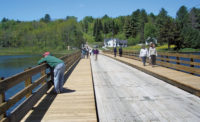Best Project: Highways/Bridges






Historic Mystic Movable Bridge Rehabilitation, Groton and Stonington, Conn.
This historic drawbridge needed rehabilitation to correct operational deficiencies and meet current design standards. The span, built in 1922 and one of the country's two remaining functional Thomas Ellis Brown-designed bascule bridges, carries US Route 1 with two lanes of traffic over the Mystic River between Groton and Stonington, Conn.
The project included restoring the charm of the nearly 100-year-old structure, work that included full cleaning and repainting of all the structural steel.
The team had a tight schedule of three short winter work seasons to perform the work. This was done to eliminate construction during the busy tourist and boating seasons and to reduce noise and disruption to the community. The team limited the amount of roadway restrictions and bridge closures.
Electric motor power raises the bridge and drives the large "bull wheels" connected with linkage arms to two plate girders that make up the bascule span. The huge concrete weights at the end of the overhead rocking trusses counterbalance the bascule span through another set of linkages.
The team developed a shoring and jacking plan to use eight W36 beams paired with diaphragms, stacked and bolted together, to achieve two 70-ft-long by 6-ft-deep plate girders as the primary support for the 600-ton counterweights and balance truss.
A forward support using the diagonal leg of the existing truss tower columns supported the load out in front of the counterweight trunnion bearings and provided two additional locations to jack and adjust the location of the balance truss and counterweights.
The designer says that the method allowed the team to perform the job during the winter and negated the need for pile driving in the navigation channel near historic buildings.
There were constraints to working over the river without contaminating the water with the lead-based paint and asbestos from the old structure. Hazardous materials containment was required during the blast cleaning to prevent potential exposure to the environment.
A regulated area was established through the use of appropriate barrier tape to control unauthorized access into the work area throughout the lead paint removal activity.
Containment activity also included engineering controls such as critical barriers, poly drop cloths, negative pressure, local exhaust ventilation and wet dust suppression methods to prevent the spread of lead. Earplugs were also distributed to pedestrians during the noisy blast cleaning process.
Due to the presence of asbestos on site, the project specification stipulated the use of encapsulants, glovebag assemblies, mastic removal chemicals, air filtration and HEPA vacuums as necessary to effectively contain the asbestos.
The judges praised the team's ability to manage the difficult logistics on this project. The bridge was "covered in lead, above a river and had to be encapsulated, in a city," said one judge. "Sometimes smaller projects [like this one] require a lot more ingenuity in doing things."
Key Players
Owner Connecticut Dept. of Transportation
General Contractor Cianbro
Prime Consultant/Lead Designer TranSystems Corp. of Connecticut
Liaison Services Close, Jensen and Miller PC
Subcontractors Stafford Bandlow Engineering Inc.; The Flanders Engineering Group





